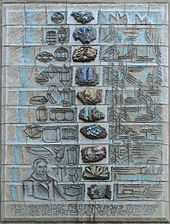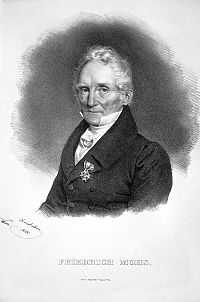Friedrich Mohs
| Friedrich Mohs | |
|---|---|
|
Friedrich Mohs, 1832 | |
| Born |
29 January 1773 Gernrode, Holy Roman Empire |
| Died |
29 September 1839 Agordo, Kingdom of Lombardy–Venetia |
| Fields | geology, mineralogy |
| Known for | Mohs scale of mineral hardness |
Carl Friedrich Christian Mohs (29 January 1773 – 29 September 1839) was a German geologist/mineralogist.
Career
Mohs, born in Gernrode, Germany, studied chemistry, mathematics and physics at the University of Halle and also studied at the Mining Academy in Freiberg, Saxony. After assuming the position of a foreman at a mine in 1801, Mohs moved in 1802 to Austria, where he was employed in trying to identify the minerals in a private collection of a banker. In 1812 he moved to Graz where he was employed by Archduke Johann in his newly established museum and science academy, which was subsequently divided into the Joanneum and the Graz University of Technology
Mineral properties

As part of this task, he started classifying minerals by their physical characteristics, in spite of their chemical composition, as had been done traditionally. This emphasis on physical characteristics was at odds with the prevailing chemical systematics. However, both Theophrastus and Pliny the Elder had compared the relative hardness of minerals known to them in the ancient world, including diamond and quartz. They knew that diamond could scratch quartz, so showing it to be harder. This became the basis of the hardness scale developed by Mohs. Minerals are now classified by chemical characteristics, but the physical properties are still useful in field examination.
Later career
In 1812, Mohs became a professor in Graz, and moved six years later to Freiberg, Saxony, before finally settling down to practice his profession in Vienna in 1826. Mohs died during a trip to Agordo, Italy in 1839, at the age of 66.
See also
Bibliography
- Wilhelm von Gümbel: Mohs, Friedrich. In: Allgemeine Deutsche Biographie (ADB). Band 22, Duncker & Humblot, Leipzig 1885, S. 76–79.
- Josef Zemann: Mohs Friedrich, Montanist, Mineraloge und Kristallograph. In: Österreichisches Biographisches Lexikon 1815–1950 (ÖBL). Band 6, Verlag der Österreichischen Akademie der Wissenschaften, Wien 1975, ISBN 3-7001-0128-7, S. 345.
- Friedrich Mohs. In: Austria-Forum
- Johannes Uray, Chemische Theorie und mineralogische Klassifikationssysteme von der chemischen Revolution bis zur Mitte des 19. Jahrhunderts. In: Berhard Hubmann, Elmar Schübl, Johannes Seidl (Hgg.), Die Anfänge geologischer Forschung in Österreich. Beiträge zur Tagung „10 Jahre Arbeitsgruppe Geschichte der Erdwissenschaften Österreichs“ von 24. bis 26. April 2009 in Graz. Graz 2010, S 107-125.
References
External links
| Wikimedia Commons has media related to Friedrich Mohs. |
|
